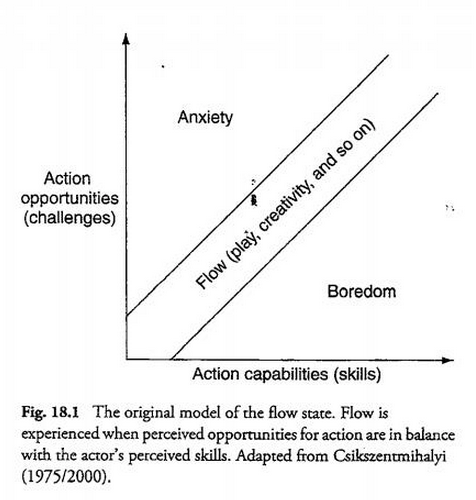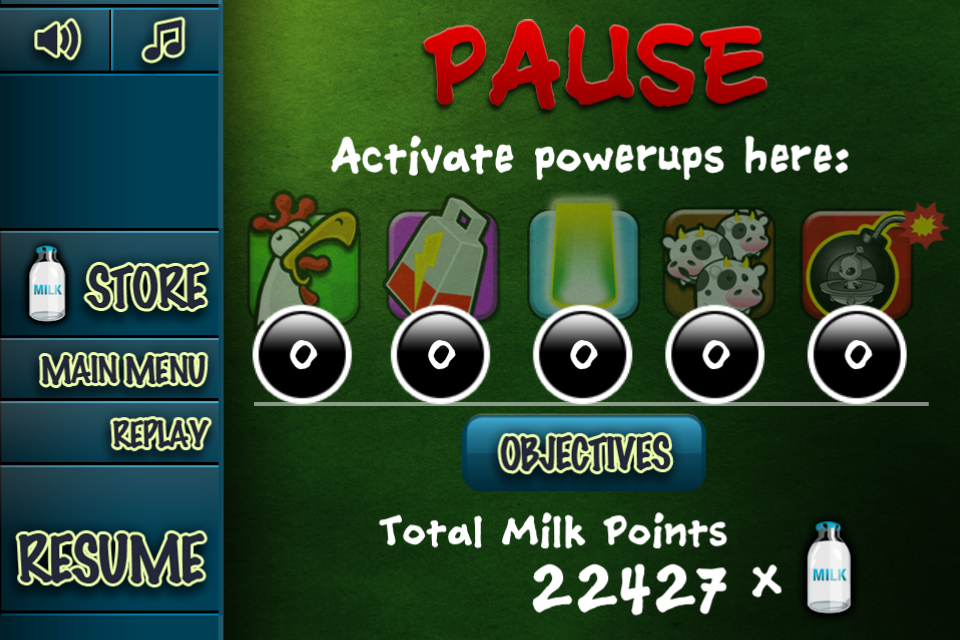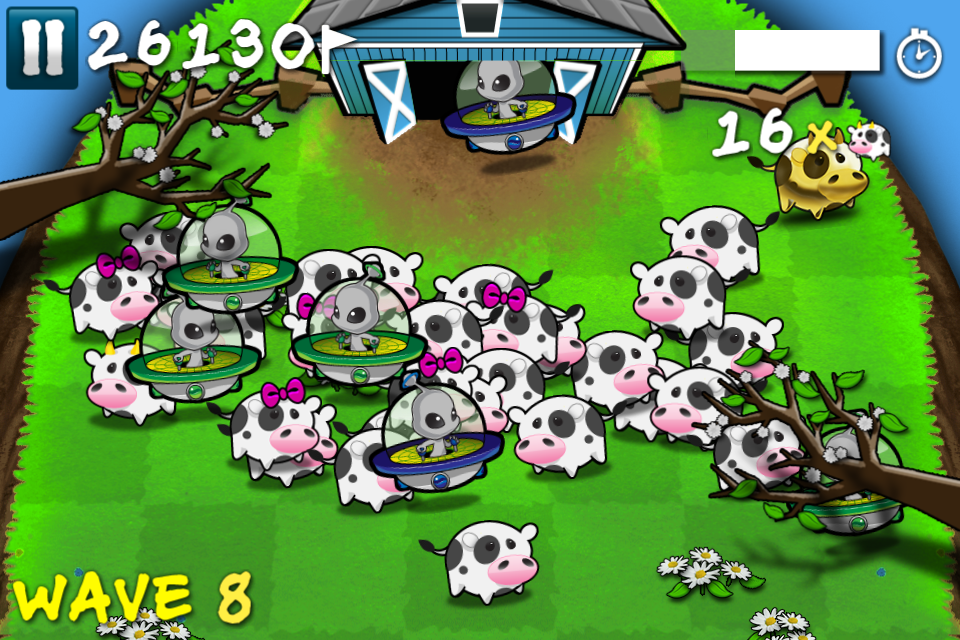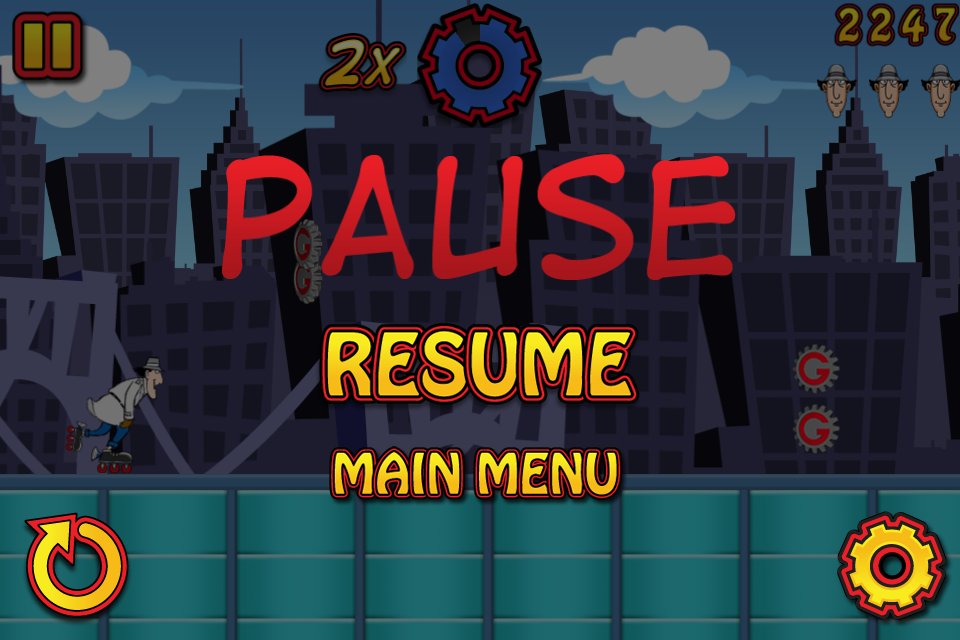Diseño de sesión móvil: fácil entrada, fácil salida
Los juegos diseñados específicamente para dispositivos móviles siempre deben tener en cuenta una cosa:
sus usuarios están distraídos.
A veces esto es contraproducente para la verdadera razón detrás de la mayoría del diseño de juegos. Queremos crear un entorno inmersivo en el que el usuario entre en esta fantasía y se vea obligado a permanecer dentro del círculo. Esto no siempre es posible con los juegos móviles. Intentar obligar a un usuario a permanecer dentro de este círculo y nunca salir de él es una lucha cuesta arriba.
La principal limitación al trabajar con dispositivos móviles es que, de hecho, son... móviles. Es posible que no estén sentados tranquilamente en una silla, en casa, con distracciones mínimas jugando a su juego. No puedes diseñar tu juego en torno a esta circunstancia ideal. Tienes que crear ese entorno inmersivo para que se ajuste perfectamente a las actividades diarias del jugador.
Tienes que diseñar tu juego teniendo en cuenta las distracciones.

El diseño de juegos móviles debe tener en cuenta a un jugador con distracciones. Específicamente cuando regresan a un juego. Se trata de gestionar el estado de fluidez de un jugador y devolverlo al "canal de fluidez" (el equilibrio entre aburrimiento y ansiedad, desarrollando sus habilidades con el tiempo) lo más rápido posible.
La inmersión sigue siendo muy posible en este entorno móvil, pero adopta formas diferentes. Tienes que diseñar tu juego de tal manera que en cualquier momento el usuario pueda irse, regresar y aún así entender qué es lo que se supone que debe hacer.
Lidiar con las distracciones también significa atender a su audiencia. Hay que diseñar mecánicas de juego que se adapten al estilo de vida del jugador. Si su público objetivo es informal, entonces su duración promedio de sesión es menor que la de un jugador principal. Tienes que diseñar la mecánica de tu juego para que tu jugador entre y salga del juego dentro de esa duración promedio de sesión. Necesitan poder entrar, alcanzar rápidamente una parte de alto valor del juego y luego tener la oportunidad de irse sin dolor.
A veces esto es difícil de incorporar en juegos que:
⦁ Depende de una narrativa sólida para guiar al jugador
⦁ Requiere muchos pasos complejos que requieren que el usuario recuerde información continua
⦁ Empuja al jugador a jugar durante largos períodos de tiempo (se requieren más de 5 minutos para jugar)
Siguiendo muchas pautas de los juegos casuales, es importante que diseñes teniendo en cuenta el juego intermitente.
Construir una mecánica que permita al jugador ingresar rápidamente al juego. Un diseño de juego que permite al jugador comprender rápidamente el estado del juego lo antes posible.
Es imperativo construir una mecánica que permita al jugador irse en cualquier momento. No puedes asumir que el jugador permanecerá en tu juego por mucho tiempo; la vida generalmente tendrá prioridad sobre el juego para el jugador.
Es importante no faltarle el respeto a sus jugadores en este momento. Un gran juego creará mucha profundidad y estrategia manteniendo estas limitaciones. Muchos juegos en la AppStore simplificarán su concepto para dispositivos móviles hasta el punto de carecer de profundidad.
Como siempre, es importante comprender y saber a quién se dirige. Si se dirige a los jugadores principales y desea introducir mucha profundidad compleja en el juego, entonces puede esperar que su base de usuarios tenga más probabilidades de tener sesiones de juego de mayor duración y minimizar las distracciones. Los juegos tienen mayor prioridad para ellos (luego la vida).
Pero incluso los jugadores habituales tienen distracciones, y permitirles jugar con profundidad mientras equilibran estas distracciones creará un juego inmersivo.
Fácil de entrar
Las llamadas telefónicas, los mensajes de texto y la vida se interpondrán en tu juego, así que asegúrate de que tu juego pueda adaptarse a las distracciones del jugador. Easy In se trata de tener una estrategia adecuada para tus jugadores cuando regresan de las distracciones. Cuando el jugador regresa al juego, debe realizar la menor cantidad de clics/pasos posible para regresar al flujo óptimo del juego (la parte más emocionante del juego).
Juegos por turnos
El diseño ideal para un juego móvil que maneja distracciones es que el jugador pueda salir del juego cuando lo desee y, al regresar, regrese al estado exacto en el que se encontraba. Los juegos por turnos pueden ejecutar esto muy fácilmente. . En un típico juego de mesa por turnos, cada turno tiene un tiempo infinito. Entonces, en caso de que el jugador se vaya debido a una distracción en medio del juego, tiene tiempo ilimitado para regresar al juego. El juego regresaría directamente al tablero de juego, donde tiene lugar el flujo óptimo del juego. Al jugador se le muestra rápidamente el estado actual del juego (todo el tablero de juego) y puede pensar fácilmente en su movimiento. Esto es ideal, ya que la jugabilidad es lo suficientemente simple como para que el estado del juego se pueda mostrar en una pantalla (el tablero) y el jugador tiene tiempo ilimitado para elegir. Los juegos casuales como Bejeweled lo hacen bien: incluso con una mecánica más arcade, cada movimiento que realiza el jugador tiene tiempo ilimitado para hacerlo. Esto permite al jugador dejar su dispositivo, no preocuparse por pausar el juego y regresar sin preocupaciones. Al regresar, pueden comprender rápidamente el estado del juego (toda la ubicación de las joyas) y realizar un movimiento a su antojo.
Angry Birds, Cut the Rope y Where's my Water tienen tiempos de turno ilimitados por una muy buena razón. El jugador puede regresar al juego desde las distracciones y alcanzar un flujo de juego óptimo lo más rápido posible.
Sometimes a player will need a little nudge. You want them to return to the optimal game flow as quickly and delicately as possible. So if the player just can’t spot the next move quick enough, it may be a good idea to “nudge” them to the right answer, so they can get back into the game quickly as possible. Bejeweled does this nicely. When a player hasn’t responded to the game in a few seconds, they add a nudge to show the player where a move is. Sometimes this can be disrespectful and insulting to the player, so use with caution. As always, understand your audience and decide how best to nudge without insulting their problem solving skills.
This ideal situation does not work for all games however. If your mechanic requires the player to make very quick responding moves or make a move within a specific amount of time, then a player coming back in the middle of a game move will cause panic. This isn’t the optimal game flow state. The casual player will panic.
Reaction Games
In arcade games, creating unlimited timed moves would absolutely kill the nature of the game. Timing, speed and panic are the core components of these games. So how do we ramp the player up quickly?
Well a naive solution is to cancel the previous game session they were having. When a player returns from a distraction, they must start from the beginning of the level. This is possible if your game sessions are 20 seconds or less. While the player will feel frustrated their 20 seconds of effort was wasted, this is a minimal punishment… but is still punishment.
The other solution is a pause menu. The player is able to pause the game at any point in the chaotic gameplay. This isn’t new. There was a reason why home console games had the “start” button in all games do this. I’m sure most parents would never had bought consoles for their kids if the pause button wasn’t invented. Many dinners would be skipped without pause menus.
It’s important to use the pause menu for a real purpose.
Cows vs Aliens used the pause menu to display briefly the game state (the player’s points, wave) and give them opportunity to trigger powerups. This doesn’t help the player return to the optimal game flow at all.
Here is how a casual player would return to Cows vs Aliens :

How a player would enter Cows vs Aliens upon returning to the game (locked screen, re enter the app)
⦁ Navigate the menu and try to find the resume button
⦁ Press the resume button

Instant Panic as the player returns to the game
⦁ Instant panic as the game snaps back to the game, there are aliens headed towards the barn.
⦁ As a casual player, they don’t respond in time, they don’t have enough time to get back into the game flow.
⦁ Game over screen.
⦁ Navigate the main menu to restart the game.
This is just an example, but in this case it would have been better for this player to just restart the whole game and start from the beginning again. The player wasn’t able to ramp up quickly enough, and because of that it took 6+ steps to get back into the optimal game flow, with a few steps making them feel inadequate of playing the game. Some players would drop out by this point.
Instead, allowing the player some ramp up time would be more ideal.

The Pause Screen is transparent
Notice in Inspector Gadget’s Mad Dash, the pause menu is transparent overlaying the actual gameplay. This is essential. Immediately when the player returns to the game, they can see the game state, can take their time, take a deep breath, then plunge back into the game flow. Just this basic design decision makes a massive difference in how players can come back into the game. In the event that the game is much further down the track, the player has a difficult jump to make, or returning to the game would cause a game over, the player can predict this when returning, and at least make the decision whether to give up and try again, or try it out. At least they are aware of their fault, and will try to fix it next time they get a distraction.
Taking this a step further, it’s important to nudge the player into the mechanic on a return as soon as possible. For more casual audiences, it may be more important to change the mechanic when the player returns from distraction to ease the player back into the mechanic. In an arcade situation, slow down the generation of obstacles, slow down the gameplay, and gradually speed the game back to its original state. Of course, close attention to exploits is important. You don’t want your player to use the pause menu to make the game easier.
Management Games
Management games, which involve the player managing their time, their town, their bakery shop, their pet shop, have challenges with managing easing a player back into the game play.
In a game like FarmVille, it can be overwhelming for a player when they come back into a game to understand what they should be doing. They have to water their crops, plant new ones, gift their friends, add more friends, purchase that new item, there’s that sale on that barn… do I need it? etc. etc. etc.
It can be a bit overwhelming. Especially as you add more steps and concurrent tasks to the player. Hyper-engaged players will not have a problem navigating this ocean of tasks, but many casual players, which you want to slowly ramp up to being more engaged can walk away when they are presented with so much choice.
In this case it’s important to think of how a returning user can be quickly ramped up in the game. The optimal player flow is for them to work through a step by step process, doing each of their required actions, then leaving the game. But that’s not fun. That’s too restrictive and requires no thought by the player. However, you can help the player organize their required tasks in a convenient list, and allow them to opt-in to following the list of steps in whatever order they choose.
When the player returns to the game, allowing them to press a button, or automatically bringing up their task list is a good idea. Each task should be a bite sized chunk of gameplay (collect all your plants, build a building, etc.). You can include some long term goals which require multiple sessions, but its important to hide these or allow the player to see them only when they’ve completed their short-term bite-sized goals first. Making these bite-sized and manageable within a few seconds allows the player to be nudged back into the core gameplay as soon as possible. It gives them a sense of accomplishment, and pushes them forward. Prioritizing quick wins over long-term victories is a great way to motivate people and to create habits.
Full Reset
Some games will restart the entire game from scratch every time the player opens the game. This is a terrible idea. While this will simplify the game start-up : the player will immediately understand what they need to do to continue (press play, start game from scratch) it clearly means that the game isn’t built with distractions in mind. If the player has to back-track and repeat more then a few steps of work to get them back to the game step they were at then this is just frustrating.
If your game can’t adapt to a player’s life then a player won’t adapt their life to play your game.
The only time which “restart completely” makes sense is when the player’s necessary steps to reach optimal flow is less if they just restarted from the beginning.
Easy Out
Easy out is all about making sure the player feels no remorse for leaving the game.
A big part to make sure this happens is having a good strategy for their return. Allowing the player to leave whenever they only works if the player knows that when they return it will be easy to get back into the game.
It’s also important to find ways to add hooks to the game so that the player has clear areas of the gameplay that they can leave without feeling like they are going to be punished on their return. Classic arcade games and the original console games were terrible at this. If you ever had to shut down your console, leave the arcade machine, you knew that your game state would be lost forever. The day your parents accidently unplugged your Nintendo console while you were in world 8 of mario surely caused scarring effects on your psyche. The day that you wrote down your MegaMan password wrong, and ended up back at the beginning made you throw the controller through the wall.
Con el móvil hemos evolucionado. Tenemos soluciones mucho mejores para esto. Asegúrate de que tu juego también haga esto. Easy Out se asegura de que el jugador no sienta remordimientos por dejar el flujo del juego. Pueden dejar el flujo del juego con la frecuencia y rapidez que necesiten.
Sin penalización por irse
La regla más importante para una salida fácil es asegurarse de que no haya penalización por irse.
Esto incluye asegurarse de que cuando regresen su dificultad no aumente. Esto sucede muchas veces sin darnos cuenta. Hacer una pausa durante un intenso juego de arcade pondrá al jugador nuevamente en medio de la refriega, esta vez sin tiempo para reaccionar al juego. Esto aumenta la dificultad y castiga al jugador por irse. Asegúrate de que el juego tenga una estrategia fácil y eficaz para gestionar este castigo.
Algunos juegos harán que el jugador regrese al juego, lo que le permitirá avanzar más fácilmente. Esto es genial para mejorar al jugador, pero debe equilibrarse con la sensación de que es un castigo por irse.
Tener pausas para el café
La otra idea importante para una salida fácil es asegurarse de tener suficientes “descansos para tomar café”. De vez en cuando, el jugador debería poder tomar un descanso de la intensidad y sentirse "bien" al irse. Contraintuitivo cuando quieres crear un entorno inmersivo, pero depende de cómo se lo presentas al usuario. Quieres intentar influir en el jugador para que abandone las buenas áreas de tu juego. Esto le permite diseñar mejor su devolución. En un juego de plataformas arcade, es mejor que un jugador deje de jugar entre niveles que durante. Si un jugador sale del juego durante un nivel, es mucho más probable que regrese al juego en un punto que lo confunda. Tener "zonas seguras" con la mayor frecuencia posible le permite al jugador regresar a un punto en el que usted, como diseñador, puede aumentarlas lo más suavemente posible. Si un jugador siente que la próxima pausa para tomar café está demasiado lejos en el futuro, es más probable que abandone el juego en un área incómoda que cuando usted lo desea.
Qué hacer y qué no hacer para entrar y salir fácilmente
HACER
⦁ Recordar al usuario qué se supone que debe hacer cuando regrese.
⦁ Tener acceso a referencias para obtener información que deben recordar de sesiones anteriores.
⦁ Tener una "lista de tareas" clara que impulse al usuario a completar tantas partes pequeñas del juego como pueda.
⦁ Tener pequeñas partes constantes de acciones del juego con pausas que permitan al jugador salir en el momento oportuno
. ⦁ Al regresar al juego, pausar el acción y permitir que el jugador regrese al juego
NO
⦁ Requerir que el jugador recuerde cosas de sesiones anteriores
⦁ Tener una historia larga e intrincada que el usuario debe recordar cada vez que juega
⦁ Tener muchos pasos complejos para cada paso del juego
⦁ Penalizar al jugador por irse de cualquier manera
⦁ Requerir que el jugador jugar durante más de 1 minuto seguido
Leave a Reply